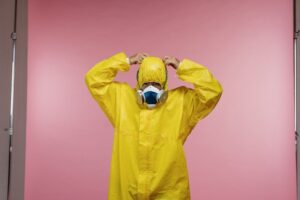What Is the Difference Between Biohazard Clean-Up and Sanitization?
 Has the recent storm and restoration around it made you wonder whether a situation requires sanitization or biohazard clean-up? While most people can comprehend how dissimilar cleaning and biohazard clean-up are, they are less clear about the difference between biohazard clean-up and sanitization.
Has the recent storm and restoration around it made you wonder whether a situation requires sanitization or biohazard clean-up? While most people can comprehend how dissimilar cleaning and biohazard clean-up are, they are less clear about the difference between biohazard clean-up and sanitization.
The 911 Restoration of PG County teams have the experience and certification required to deal with both situations and have managed cases recently as well. However, we also wanted to increase awareness and have prepared this blog post to help you become familiar with the differences between the two.
What Is a Biohazard?
Before we begin addressing the differences, let’s first quickly walk through what a biohazard is. Biohazard is short for biological hazards and refers to biological elements threatening human and animal health.
Blood and excretions are typical biohazard materials. However, several others, like spores, mold, carcasses, etc., also come under the same category. All biohazard materials are considered exceedingly dangerous, and authorities advise untrained people to steer clear of them to prevent possible exposure if possible.
Difference between Biohazard Clean-up and Sanitization
Now that there is more clarity about what biohazards are, we can better discuss and understand the difference between biohazard clean-up and sanitization. Below are the most significant dissimilarities between the two:
1. Need/Requirement
The first difference is between the two is in the situations that require one or the other. Sanitization usually helps clean up any food residue, germs and impurities, and other pollutants that can make their way inside your home or offices due to routines.
Biohazard clean-up is required for a specific set of circumstances. Below are some of the situations that require it:
- Human deaths by suicide or homicide. They can also be required if a human death occurred naturally but went undiscovered for some time and started decomposing.
- Pest infestations, especially when it involves rodents and similar animals.
- Chemical spills around industrial areas.
- Mold infestation.
- Crime scenes involving dangerous chemical substances like crystal meth or tear gas.
- Sewage buildup.
Biohazard clean-ups are also required in case of disease outbreaks. Patients are usually kept in isolation wards, and biohazard teams clean every surface or location they may encounter.
2. Equipment and Supplies
The equipment and supplies for biohazard clean-up are far more advanced and premium than those used for sanitization. While sanitization is also a critical part of maintaining hygienic conditions, restoration technicians usually need more potent chemicals to eliminate any biological residue to prevent any chances of cross-contamination and spread.
3. Safety Precautions to Avoid Contamination
Technicians involved in sanitization are expected to prevent any contaminant from remaining left behind or failing to cover all the areas. They also need to clean the area to ensure any remaining pollutants in the air get taken care of, and the client gets a clean home or office.
The safety precautions are far stricter regarding biohazard clean-ups because there is a strong possibility of the problem escalating out of control due to minor negligence. Aside from technicians wearing hazmat suits to the site, they also carry cleaning agents whose strength depends on the contamination they are dealing with.
The affected area is often sealed off to the public to prevent trespassing, especially when the contamination has affected bodies too large for quick decontamination.
Biohazard Levels
The extent of the clean-up and precautions depends entirely on how high the level of the biohazard is. Level 1s pose a minimal threat to health. Although the clean-up is comprehensive, it will not need area isolation for elongated periods.
Level 4 biohazards, however, are lethal pathogens that do not have a known treatment, like Ebola. If anyone detects such impurities in an area, they need to report them immediately. Trained experts can then isolate the area to prevent further exposure and give exposed people specific instructions on cleaning up to prevent the problem from traveling further.
4. Disposal
Professional sanitization services secure waste in sturdy containers and deposit them to waste facilities to ensure none of the contaminants come in contact with people. There are some basic rules for disposal the teams need to follow. Otherwise, the process is quick and straightforward.
Biohazard disposal is more complex and far more regulated. The teams carry biohazard waste containers and deposit the waste they find, sealing it to ensure that fumes can escape. The containers are then taken to biohazard disposal grounds and disposed of safely.
5. Risks
Biohazard clean-up is far riskier compared to sanitization due to the nature of contaminations. The biohazard team often deals with substances that can cause severe sickness and death in extreme situations.
Level 3 and Level 4 hazards are perilous for humans and animals, and even minimal exposure can put them at high risk. The higher levels of risk are why technicians always wear a hazmat suit on-site and follow SOPs when exiting the site to prevent spreading any residue.
In contrast, sanitization is relatively less risky. Lack of sanitization is extremely unhygienic and can worsen problems. However, technicians handling routine sanitization need essential protective gear to perform their duties.
Final Thoughts
To conclude, the difference between biohazard clean-up and sanitization results from the contrast between the situations they address. Biohazard clean-up involves riskier elements that pose severe threats to people’s health and life, while sanitization primarily affects hygienic conditions.
911 Restoration of PG County has certified technicians and provides both biohazard clean-up and sanitization services. If you need either service for your home or office, call us at (301) 246-8517 or contact us using this link.


